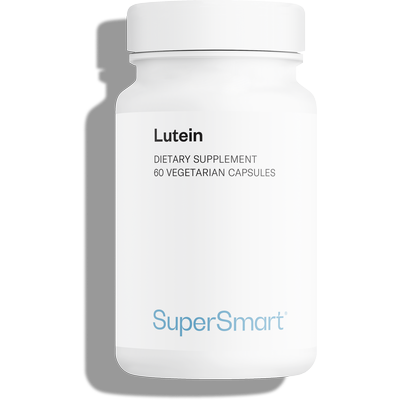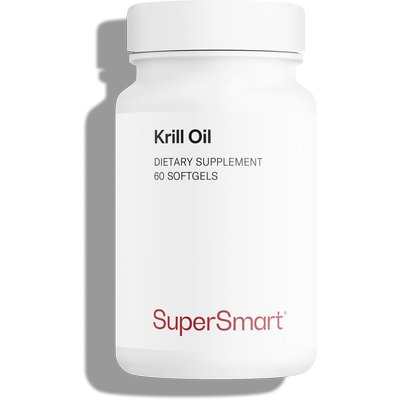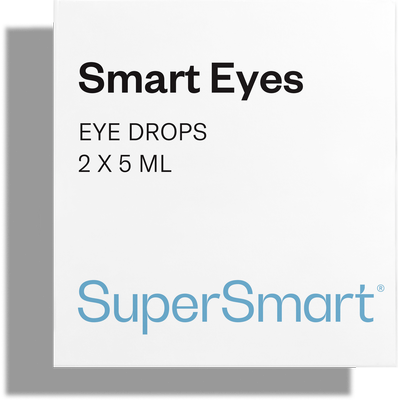Nutrients you should focus on if you care about your eyes

Contrary to popular opinion, problems with vision are largely dependent on individual lifestyle and intake of certain micronutrients. More confirmation of this has just come from scientists following close examination of 18 high-quality studies into diet and eyesight.
Along with our brains, our eyes are probably our most precious organs, but it’s only when we start to lose our vision that we fully realise it. When our eyesight fails, daily life is turned upside down: shopping, driving, filling out forms, reading a menu or watching a good film all become a massive challenge …
- 45 is the average age at which presbyopia (long-sightedness)develops. It gradually gets worse up to the age of 65 and makes reading increasingly difficult.
- 55 is the average age at which macular degeneration starts to appear, a progressive deterioration of the macula, the small area of the retina located at the back of the eye. It causes gradual and sometimes significant loss of central vision which becomes more and more blurred.
- 65 is the average age at which the majority of people start to develop cataracts. This disorder is characterised by opacification of the lens which gradually leads to impaired vision. Colours become duller, objects look as if they’re behind a white veil and vision becomes clouded.
Nourishing your eyes throughout life with the right micronutrients can, however, make all the difference in pushing back these alarming milestones. Many studies show that good eye nutrition can be effective even when vision has already begun to deteriorate …
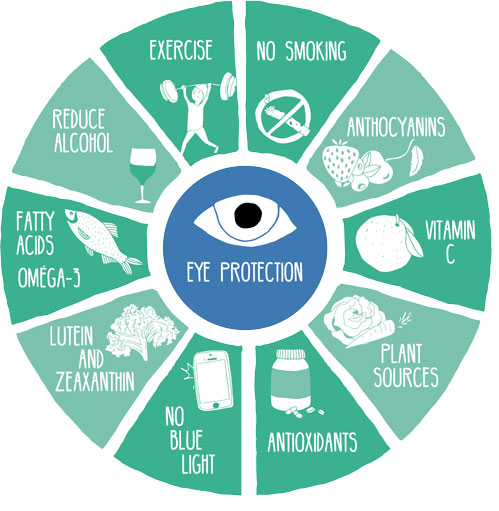
Lutein and zeaxanthin can make a huge difference
Research using donor eyes has demonstrated high concentrations in almost all the eye’s tissues of three carotenoid pigments: lutein, zeaxanthin and meso-zeaxanthin.
These compounds protect the macula by absorbing the most dangerous, high-energy light rays. They fulfil the exact same role in the leaves of plants exposed to radiation from the sun. Acting as ‘shields’, they combat attack from harmful free radicals generated by radiation: without them, it would be the essential components in our cells that would be in the firing line and the above-mentioned diseases would develop much sooner. The problem is that this defence system is completely dependent on our diet as the body is unable to produce these compounds.
We therefore need to obtain them from food, in particular, from dark green vegetables. But these foods are becoming less and less popular, probably because people today are unwilling to spend the necessary time preparing and cooking them. Yet this should be thought of as time well-spent: dozens of studies have shown that an adequate intake of lutein and zeaxanthin can improve eye health and lower the risk of age-related sight problems (1-11). And the review mentioned at the beginning of this article has only added to this evidence.
With regard to meso-zeaxanthin, it does not feature in the human diet. It’s thought that lutein is partly converted into meso-zeaxanthin after ingestion, primarily in the macula.
How much lutein and zeaxanthin do you need?
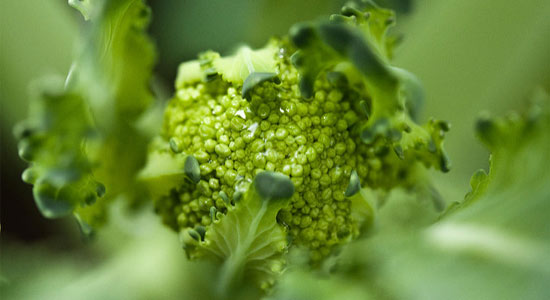
Studies have demonstrated benefits from an intake of 10mg of lutein a day. This is considerably higher than the amount thought to be ingested by adults in the West – barely 1-2mg a day, according to a study in the journal Nutrition.
Summary table of vegetables rich in lutein and zeaxanthin (per 100 g) :
|
Extract of marigold (one capsule) |
20 mg |
|
Kale |
19.6 mg |
|
Spinach |
15.7 mg |
|
Turnip greens |
11.9 mg |
|
Chard |
11 mg |
|
Collard greens |
10.9 mg |
|
Watercress |
5.8 mg |
|
Green peas |
2.6 mg |
|
Lettuce |
2.3 mg |
|
Broccoli |
1.4 mg |
Although eggs are not on this list, they are also good sources of lutein and zeaxanthin: they have fewer total carotenoids but what they do have are present in a highly absorbable form – provided, that is, you choose eggs laid by healthy chickens! It’s easy to tell – the yolk is bright, unlike the dull, almost grey yolk of malnourished battery hens. The more orangey the yolk, the higher the content of lutein and zeaxanthin.
If you prefer to take supplements, which are just as effective, be sure to avoid products which say they contain lutein but in fact provide a completely inadequate amount (0.20 mg-2.0 mg per dose). For a significant effect, you need 6g-20mg per dose, as is provided by the supplement Lutein 20 mg, produced exclusively from marigold plants.
Vitamin C to combat cataracts
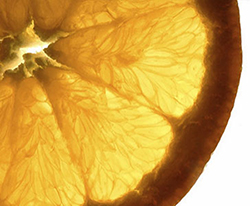
A number of studies suggest that a higher intake of vitamin C helps prevent cataracts. One in particular (12)stands out: scientists who studied the vitamin C intake of 324 pairs of twins for more than 10 years noted a 30% lower risk of cataract in the twin with the higher intake. Epidemiological data had already suggested a correlation between high levels of vitamin C in the blood and reduced incidence of cataract (13-15).
As is the case with lutein, the body is unable to produce vitamin C and we therefore have to rely on dietary sources for this valuable antioxidant. Brightly-coloured fruits and vegetables contain the most vitamin C: red peppers, oranges, strawberries, blueberries, raspberries, cherries, tomatoes, grapefruit, lemons, broccoli … In summer, these foods are easy to find, but in winter, it’s a different story! We instead have to rely on vegetables, but it’s important to eat them as close to their natural state as possible, as vitamin C is easily destroyed by water and heat …
Omega-3 to improve blood flow in eye capillaries
A recent study showed that diabetics who consume two portions of omega 3-rich oily fish a week reduce their risk of retinopathy by almost half (16). This is an important benefit as retinopathy is a serious and relatively common complication of diabetes. Even if you’re not diabetic, you can also benefit from omega 3 fatty acids: an earlier study showed that people with the highest intakes of omega 3 had a 60% lower risk of developing macular degeneration than those with the lowest intake. It’s hard to say whether these effects are related to omega 3’s anti-inflammatory properties or to their central role in developing retinal cell membranes. It could, of course, be their ability to ‘clean up’ blood vessels … because maintaining healthy photoreceptor cells requires a perfectly-functioning vascular network in the eye. Not just so that antioxidants can be directed towards the retina, but because photoreceptors require a significant amount of oxygen and are constantly producing vast quantities of waste-products which need to be eliminated as quickly as possible. If your capillaries are clogged, neither of these two essential processes can take place normally, increasing the likelihood of diseases such as glaucoma or macular degeneration (17).
There’s only one problem here: fish are the best sources of omega 3 and we know that heavy metals and pollutants accumulate in fish. Given that the WHO itself advises against eating more than two portions of oily fish a week, we have quickly had to look instead to omega 3 supplements derived from krill oil, the tiny crustaceans that populate the cold waters of the Antarctic …
Why is there such a high level of oxidative stress in the eyes?
The retina undergoes the most renewal of all the body’s tissues which inevitably involves constant production of free radicals. And as you’re now aware, the eyes are highly exposed to the sun’s ultraviolet rays which are a major source of potentially harmful free radicals.
These reactive molecules primarily attack polyunsaturated fatty acids which are highly concentrated both in ocular cell membranes and the fragile cones of the macula’s photoreceptors. When endogenous antioxidants (those produced by the body) and those provided by the diet are no longer able to keep them in check, irreparable damage occurs. If the situation persists over time, this damage accumulates until the consequences become so serious that eye function is disrupted. (18)
So it’s important to do all you can to delay this situation as long as possible. Eye dysfunction is inevitably accompanied by chronic inflammation which in turn leads to the production of pro-oxidant mediators (19), exacerbating all your problems. It’s a truly vicious circle …
Don’t forget about anthocyanins in berries
During the Second World War, experienced pilots encouraged their younger colleagues to eat blueberries to improve their night vision. This unusual move led researchers to study the eye-related properties of blueberries and over the last few years, they have identified a number of benefits (20-23):
- Improvement in retinal sensitivity
- Preservation of visual function
- Preservation of lachrymal function
- Improvement in vascular circulation in the eye
- Relief of ocular fatigue (following intensive use of the eyes)
- Protection against ageing of the eyes
All these benefits are related to the blueberry’s anthocyanin content. Anthocyanins are antioxidant compounds which belong to the large flavonoid family and which are completely absent in animals. They are able to prevent photo-oxidation induced by light, particularly that affecting lipofuscin (24), a pigment that accumulates over time in retinal epithelial cells, increase ocular levels of endogenous antioxidants such as glutathione and superoxide dismutase (25), and improve capillary vasomotion in the eye, a property which we have already mentioned is important for visual function.
That’s why the natural formulation Eye Pressure Control contains a real blueberry extract (Vaccinium myrtillus) standardised to 36% anthocyanins, obtained exclusively from fresh blueberries. It also contains Pycnogenol®, an extract of French maritime bark which promotes blood vessel dilation in the eye. It’s the perfect formulation for anyone looking to preserve their visual acuity and for those suffering from diabetes, hypertension or cardiac problems (serious risk factors for glaucoma).
Perhaps even more importantly: avoid blue light!
You’ve probably heard the warnings about the risks posed by blue light emitted by screens… Don’t ignore them: as well as slowing down production of melatonin, the sleep hormone, it presents a serious risk to eye health. Blue light waves are not the same as natural light waves – they are much higher in energy and as a result, cause much greater damage to our photoreceptor cells. And as we don’t yet know whether ‘anti-blue light’ glasses really work, it’s better to limit your screen exposure as much as possible.
If you have to use a computer every day for work, at least you’re now aware that you face a higher risk of retinal damage and that theoretically, your need for antioxidant protection is greater. Forewarned is forearmed …
Some additional advice for maintaining good eyesight
The study mentioned in the introduction also reiterates the need to limit intake of alcohol, sugar and saturated fats which clog the artery walls. Instead, eat a Mediterranean diet, with plenty of fruit, vegetables, whole grains and polyunsaturated fats.
If you’re a smoker, be aware that you’re 2-3 times more likely to suffer problems with eyesight than a non-smoker (26). Cigarette smoke significantly increases free radical production in the eyes as it does in almost all tissues in the body.
Last but not least, here’s a piece of advice that can’t be repeated often enough: take some exercise! Regular exercise is good for cardiovascular health and slows down the progress of macular degeneration by around 25% (27).
Particular individuals who should re-read this article
These diseases hang over all of us but as you’re now aware, the risk of developing them is not the same for everyone. The choices we make in life have a huge influence on our individual risk, as do genetic factors, family history, and obviously, age. The following people are at a particularly high risk of falling victim to these diseases prematurely:
- Those with family members affected by macular degeneration.
- Those with light-coloured eyes.
- Those who’ve smoked during their lifetime.
- Those who suffer from hypertension.
- Those with type 1 or type 2 diabetes.
- Those who are overweight.
- Those who live in sunny regions.
- Those over 55.
- Those who suffer or have suffered in the past from vascular problems (such as a heart attack, stroke or atherosclerosis) and whose retinal blood vessels are probably in a worse than average condition.
- Those who are exposed daily to a computer screen.
In summary
These days, our eyes suffer levels of oxidation not known by our forebears. This is partly because we’re living longer, but also because we’re no longer eating enough antioxidant-rich fruits and vegetables, and because we’re exposed to many more sources of oxidation (blue light, chronic stress, lack of sleep, air pollution, alcohol consumption and smoking)…). Fortunately, as this article explains, it is not too late to take action …
Study at the centre of this article
Chapman, N. A., Jacobs, R. J. and Braakhuis, A. J. (2018), Role of diet and food intake in age‐related macular degeneration: a systematic review. Clin. Experiment. Ophthalmol.. . doi:10.1111/ceo.13343
Références
- Hankinson SE, Stampfer MJ, et al. Nutrient intake and cataract extraction in women : a prospective study. BMJ. 1992 Aug 8;305(6849):335-9.
- Brown L, Rimm EB, et al. A prospective study of carotenoid intake and risk of cataract extraction in US men.Am J Clin Nutr. 1999 Oct;70(4):517-24.
- Chasan-Taber L, Willett WC, et al. A prospective study of carotenoid and vitamin A intakes and risk of cataract extraction in US women.Am J Clin Nutr. 1999 Oct;70(4):509-16.
- Lyle BJ, Mares-Perlman JA, et al. Antioxidant intake and risk of incident age-related nuclear cataracts in the Beaver Dam Eye Study. Am J Epidemiol. 1999 May 1;149(9):801-9.
- Hammond BR Jr, Johnson EJ, Russell RM, Krinsky NI, Yeum KJ, Edwards RB, Snodderly DM. Dietary modification of human macular pigment density. Invest Ophthalmol Vis Sci. 1997 Aug;38(9):1795-801.
- Landrum JT, Bone RA, Joa H, Kilburn MD, Moore LL, Sprague KE. A one year study of the macular pigment: the effect of 140 days of a lutein supplement. Exp Eye Res. 1997 Jul;65(1):57-62
- Bone RA, Landrum JT, Dixon Z, Chen Y, Llerena CM. Lutein and zeaxanthin in the eyes, serum and diet of human subjects. Exp Eye Res. 2000 Sep;71(3):239-45
- . Beatty S, Murray IJ, Henson DB, Carden D, Koh H, Boulton ME. Macular pigment and risk for age-related macular degeneration in subjects from a Northern European population. Invest Ophthalmol Vis Sci. 2001 Feb;42(2):439-46
- Bone RA, Landrum JT, Guerra LH, Ruiz CA. Lutein and zeaxanthin dietary supplements raise macular pigment density and serum concentrations of these carotenoids in humans. J Nutr. 2003 Apr;133(4):992-8
- Annu Rev Nutr. 2003;23:171-201. Epub 2003 Feb 27. Biologic mechanisms of the protective role of lutein and zeaxanthin in the eye. Krinsky NI, Landrum JT, Bone RA
- Rosenthal JM, Kim J, de Monasterio F, Thompson DJ, Bone RA, Landrum JT, de Moura FF, Khachik F, Chen H, Schleicher RL, Ferris FL 3rd, Chew EY. Dose-ranging study of lutein supplementation in persons aged 60 years or older. Invest Ophthalmol Vis Sci. 2006 Dec;47(12):5227-33
- Yonova-doing, Forkin et al. Genetic and Dietary Factors Influencing the Progression of Nuclear Cataract, Opthalmology June 2016; 123(6): 1237-1244
- Ferrigno L, Aldigeri R, et al. The Italian-American Cataract Study Group. 25. Associations between plasma levels of vitamins and cataract in the Italian-American Clinical Trial of Nutritional Supplements and Age-Related Cataract (CTNS): CTNS Report #2. Ophthalmic Epidemiol. 2005 Apr;12(2):71-80.
- Vitamin C is associated with reduced risk of cataract in a Mediterranean population. Valero MP, Fletcher AE, et al. J Nutr. 2002 Jun;132(6):1299-306.
- Blood levels of vitamin C, carotenoids and retinol are inversely associated with cataract in a North Indian population. Dherani M, Murthy GV, et al. Invest Ophthalmol Vis Sci. 2008 Aug;49(8):3328-35.
- Hanna Shevalye, Matthew S Yorek, Lawrence J Coppey, Amey Holmes, Matthew M Harper, Randy H Kardon, Mark A. Yorek. Effect of enriching the diet with menhaden oil or daily treatment with resolvin D1 on neuropathy in a mouse model of type 2 diabetes. Journal of Neurophysiology, 2015; jn.00224.2015 DOI: 10.1152/jn.00224.2015
- Kuroki M, Voest EE, Amano S, Beerepoot LV, Takashima S, Tolentino M, et al. Reactive oxygen intermediates increase vascular endothelial growth factor expression in vitro and in vivo. J Clin Invest 1996 ; 98 : 1667-75.
- Desmettre T. Stress oxydant et DMLA. Réalités ophtalmologiques 2004 ; n° 111.
- Beatty S, Koh H, Phil M, Henson D, Boulton M. The role of oxidative stress in the pathogenesis of age-related macular degeneration. Surv Ophtalmol 2000 ; 45 : 115-34
- Kim E.S., J. Clinical Evaluation of Patients with Nonproliferative Diabetic Retinopathy Following Medication of Anthocyanoside: Multicenter Study, Korean Ophthalmology Soc., 2008;49(10):1629-1633.
- Mazzolani F. et al., The effect of oral supplementation with standardized bilberry extract (Mirtoselect®) on retino-cortical bioelectrical activity in severe diabetic retinopathy, Minerva Oftalmol 2017 June;59(2)_38-41
- Riva A, Togni S et al. The effect of a natural, standardized bilberry extract (Mirtoselect®) in dry eye: a randomized, double blinded, placebo-controlled trial. Eur Rev Med Pharmacol Sci. 2017 May;21(10):2518-2525.
- Virno M, Pecori Giraldi J, Auriemma L. Antocianosidi di mirtillo e permeabilità dei vasi del corpo ciliare. Boll Ocul. 1986;65:789–95.
- Sparrow JR, Vollmer-Snarr HR, Zhou J, Jang YP, Jockusch S, Itagaki Y, Nakanishi K. A2E-epoxides damage DNA in retinal pigment epithelial cells. Vitamin E and other antioxidants inhibit A2E-epoxide formation. J. Biol. Chem., Vol. 278, Issue 20, 18207-18213 (2003).
- Yao N. Protective effects of bilberry (Vaccinium myrtillus L.) extract against Endotoxin-induced uveitis in mice. J. Agric. Food Chem., 2010, 58 (8), pp 4731–4736
- Armstrong RA, Mousavi M. Overview of risk factors for age-related macular degeneration (AMD). J Stem Cells 2015; 10: (3): 171-91
- Natural Standard (Ed). Medical Conditions – Macular degeneration, Nature Medicine Quality Standards. [Consulté le 25 juillet 2018]. www.naturalstandard.com
All rights reserved
Free
Thank you for visiting our site. Before you go
REGISTER WITHClub SuperSmart
of exclusive benefits:
- Free: our weekly science-based newsletter "Nutranews"
- Special offers for club members only



